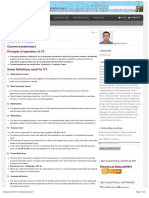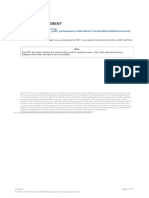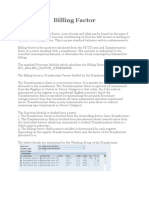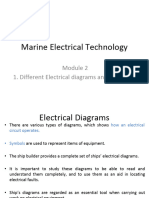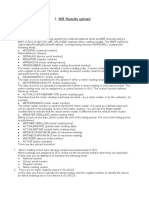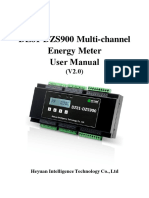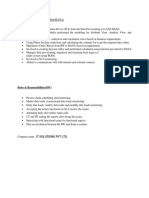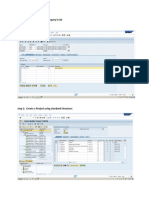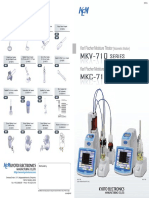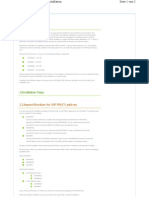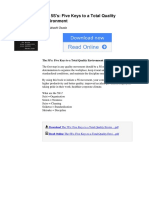You require a device category in order to create or deliver devices.
Depending on the basic device category, you must first maintain the following data in order to create a device
category:
register group, for the basic device categories:
o
Meter
Remote meter
Corrector
Other
Command group
o
For basic device category ARCR/clock
Winding group
o
For basic device category "transformer"
Requirements
Define serial number profile
In order to serialize devices of a device category, the reference material master must specify a
serial number profile.
In order to define a serial number profile, you must first make the following settings:
Maintain equipment category
Plant Maintenance and Service Management -> Equipment und Technical objects -> Technical
Objects -> Equipment -> Equipment Categories -> Maintain equipment category
Define equipment categories for IS-U
Utilities Industry -> Device Management -> Technology -> Device -> Define equipment
categories for IS-U
If you wish to indicate that a device is "subject to external certification", table TE270 must be
maintained.
�Define Help Table for Specification of Material Reference
If you do not want to use standard functions (inventory management, warehouse management,
classification system) for device management, you must enter a reference material that meets your
requirements.
If you want to use the standard fuctions, you should first define a material in the standard system for
each device category that you create, and then specify it in the Device category field on the initial
screen of Create device category.
You must maintain the following views if you execute the function Create material in the standard
system for IS-U purposes:
o
Basic data 1
Sales and distribution: general plant data
Accounting 1 (only if you have selected the Copy valuation view from material
reference field)
Copy valuation view of material reference
When active, the material valuation from the material template will also be created when the material is
created from a material template.
The table permits only one entry. Therefore, you cannot enter a further material reference via New entries.
you define the loss determination groups for voltage losses of a power transformer.
You define function classes for specific division categories.
In this activity, you define construction classes for specific function class - division category
combinations.
When used in conjunction with function classes, construction classes enable you to
summarize device categories on the basis of device category description and function.
�You may define a function class for several construction classes, but you may not define different
functions for the same construction class.
Register group
Define Register Types
In this activity you define the permissible register types of registers. The register type classifies registers
in rate time zones.
Define Register IDs
In this activity you define the register identification of the registers dependent on the division category.
The register identification describes the function of a register.
Allocate Units of Measurment to Register Categories
In this IMG activity, you allocate Dimensions to individual division and register categories.
Example
Div. cat.
| Register category
| Dimension
--------------------------------------------------------Electricity | Cumulative watt regoster
Electricity | Cumulative watt register
| POWER
| POWER
Electricity | Cumulative consumption register | ENERGY
�Define Search Terms for Register Groups
In this section you define the search terms for register groups dependent on the division category. The
freely definable search terms are for classifying register groups.
Example
DC | Search term | Text for search term
--------------------------------------01 | 0001
| Alternating current meter
01 | 0002
| Three-phase current meter
02 | 0001
| Gas meter
02 | 0002
| Corrector
DC = Division category
The following search terms are dependent on division category: register group, input/output group
and inspection point group
whereas the search terms command group and winding group are not dependent on division
category. This is because command groups are only used in audiofrequency ripple control receivers
(ARCR) and winding groups are only used in transformers, which both belong to the division for
electricity.
Register factor
Constant dependent on the construction type. It is multiplied by the meter reading result to obtain the actual
consumption
Number of meter reading results per meter reading
Number of meter reading results that the register saves and makes available for multiple meter reading order
creation.
�The system creates as many meter reading orders as necessary.
Dependencies
If you enter several meter readings here, you can calculate an average value in billing.
Control group for multiple meter reading order creation
Use
Combines parameters used to create meter reading orders for interim meter reading during multiple meter
reading order creation.
You specify the control group in the register data of the device.
Transformation ratio
The transformation ratio specifies the conversion factor used by the register to which a transformer is
connnected.
The transformation ratio can be specified for the device category, for the device, and for register.
The transformation ratio for the register overwrites the ratio for the device and
the ratio for the device overwrites the ratio for the device category.
The transformation ratio can only be specified if the measuring type of the device category is 1 or 2 (i.e. for
semi-indirect or indirect measuring).
Register factor: primary transformer voltage
This field contains the value of the primary transformer voltage, which is already considered in the register
design as part of the transformation ratio for a primary register of a current meter/remote register.
�Specify the respective absolute values (e.g. 10,000 V, 5,800 V) since the program uses these in the calculation
of the transformation ratio.
Register factor: secondary transformer voltage
This field contains the value of the secondary transformer voltage, which is already considered in the
register design as part of the transformation ratio for a primary register of a current meter/remote register.
Specify the respective absolute values (e.g. 10,000 V, 5,800 V) since the program uses these in the calculation
of the transformation ratio.
Register factor: primary transformer current
This field contains the value of the primary transformer current, which is already considered in the register
design as part of the transformation ratio for a primary register of a current meter/remote register.
The program uses these specifications in the calculation of the transformation ratio of the transformer group.
Register not relevant to billing
Means that the meter reading of this register is not relevant for billing.
For all registers except resetting registers, this field and the rate type can be combined as follows:
Field selected, rate type specified
The register is read as if the field had not been selected.
(The result from a control meter, for example, can be used for checking readings entry. )
However, such meter readings are not processed during billing:
o
During billing, rate determination is not carried out for the rate type of the register. The rate of
the register is not billed unless it is determined via another billing-relevant register.
The register readings cannot be printed on the bill.
A rental price is not charged for the register.
This does not apply to registers switched in series.
When primary meters are billed, consumption from all registers is processed. Meter readings from
secondary meters are therefore also processed during billing if the indicator is set.
Field selected, rate type not specified
�The register is not billed.
Field not selected, rate type specified
The register must be read so that it can be used for billing.
In this case, therefore, the Do not read field must not be selected. Otherwise an error occurs during
billing.
If the meter reading is only to be taken in order to display the meter reading result on the bill, then at
least one variant must be entered in the rate found via the rate type. This variant writes one info line
for each meter reading result.
Field not selected, rate type not specified
This combination produces an error in billing because every register relevant for billing must have a
rate type.
Dependencies
The N (register not relevant for billing) field is only effective when the Do not read (do not read
register) field is not selected.
If the N (register not relevant for billing) field is selected for all registers and no rate type is specified in
the installation or rate category facts, billing is terminated as no rate is found.
